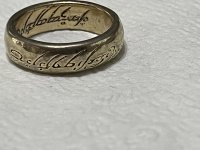Twobrothers
Jr. Member
- Jun 7, 2017
- 63
- 53
- Primary Interest:
- Other
Ive been hard rock prospecting a particular known gold bearing area for a couple months now and would like the opinion of more experienced hard rock prospectors/ miners on the photographs of a few samples.
The area is a known placer gold producer with the bulk of production taking place between 1890's and 1930's. Some large nuggets were recovered. An 8 ounce-er, to one over a pound made quite a stir. Most of the creek bed is covered by active current placer claims. There are some historical hard rock claims in in the area. Most produced at least some gold as a commodity. The few historical assay and smelter reports I've found indicate some representative ore material with 1-3 oz/ ton of gold. A few high grade shipments to smelters indicate material with 14-29 oz/ ton of gold. I've visited a few of them and they are not easily accessible. Ive taken some samples from the most promising lead which I sent off for a silver/gold fire assay about a week and a half ago. The ore material is a quartz vein finely layered with oxidized iron and limonite after sulfides. The material I am interested in occurs in thin sheets. Here are some pictures of the material.
View attachment 1469215 View attachment 1469214 View attachment 1469212 View attachment 1469213
The first picture is a piece from a 15 pound piece of the vein I sampled and quartered. I sent off two opposing quarters of the chunk for Ag/Au fire assay. This is one of the two quarters still in my possession and is fairly representative of what I sent in for assay.
The second picture is a thin flake off of an exposed section of the vein. About 1/4 in thick with many thin layers throughout.
Third picture is the same material opposite side.
Fourth picture is one of the first pieces of material I found in the vein structure that got me excited about this location as a prospect.
Feedback welcome. Eagerly awaiting assay results.
The area is a known placer gold producer with the bulk of production taking place between 1890's and 1930's. Some large nuggets were recovered. An 8 ounce-er, to one over a pound made quite a stir. Most of the creek bed is covered by active current placer claims. There are some historical hard rock claims in in the area. Most produced at least some gold as a commodity. The few historical assay and smelter reports I've found indicate some representative ore material with 1-3 oz/ ton of gold. A few high grade shipments to smelters indicate material with 14-29 oz/ ton of gold. I've visited a few of them and they are not easily accessible. Ive taken some samples from the most promising lead which I sent off for a silver/gold fire assay about a week and a half ago. The ore material is a quartz vein finely layered with oxidized iron and limonite after sulfides. The material I am interested in occurs in thin sheets. Here are some pictures of the material.
View attachment 1469215 View attachment 1469214 View attachment 1469212 View attachment 1469213
The first picture is a piece from a 15 pound piece of the vein I sampled and quartered. I sent off two opposing quarters of the chunk for Ag/Au fire assay. This is one of the two quarters still in my possession and is fairly representative of what I sent in for assay.
The second picture is a thin flake off of an exposed section of the vein. About 1/4 in thick with many thin layers throughout.
Third picture is the same material opposite side.
Fourth picture is one of the first pieces of material I found in the vein structure that got me excited about this location as a prospect.
Feedback welcome. Eagerly awaiting assay results.





